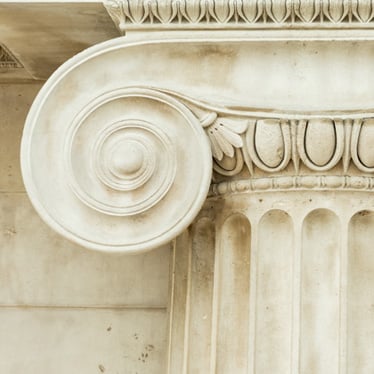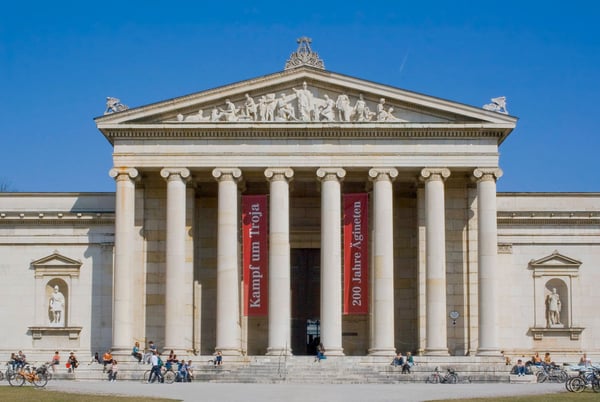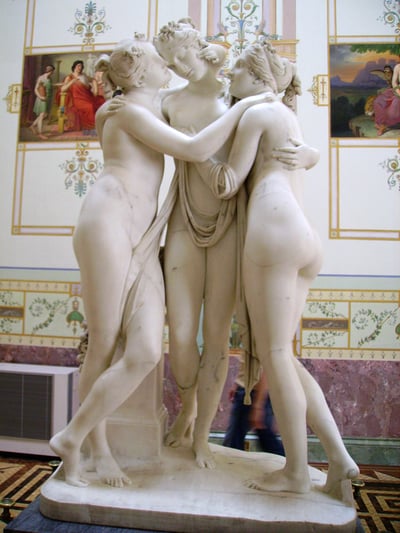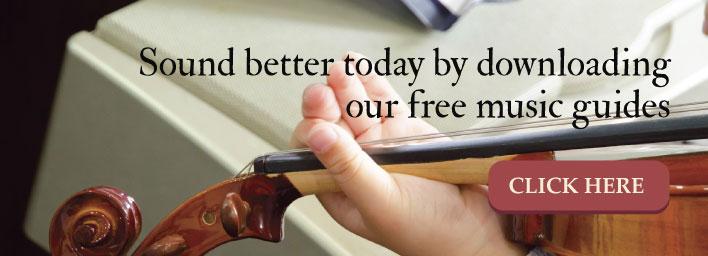Period in Europe in Which Patronage of the Arts Shifted From the Church to the Noble Courts
The Classical Period of Music
Published by StringOvation Team on Apr 12, 2019

The Classical Period of music may have given its name as the popular descriptor for all of Western sophisticated instrumental composition, merely its bodily timeline is relatively short. All of the other delineated musical eras get at least a full century. Yet, the Classical Era is often cited as the latter half of the eighteenth century. At its longest, the Classical Era ran just lxx to eighty years, ending no after than 1820. Despite the Classical Era's short run, its impact on instrumental music has been enormous. The period takes the appellation "Classical" due to the philosophical and cultural render to the classical values of antiquity, which profoundly influenced musical composition. The Baroque Era ended Europe's first render to the philosophical and artistic values of classical Rome and Hellenic republic. The Classical Era, in plough, was a articulate break from the Bizarre style. In this article, you'll find Classical Era music'southward primary characteristics, how information technology differs from what came before, and how its proper name has come to exist used as the holonym for Western instrumental music. Most modern music fans would well-nigh probable observe it odd to learn that the music of the Classical Era adult from a search for a simpler, cleaner, more humanistic musical expression with universal qualities and appeal. As part of its reach towards universality, Classical Period composers drew on a combination of qualities, each prevalent in different European traditions. Composers from all over Europe drew on the formality and precision from the Germans, lyrical artistry from Italy, and technical adroitness valued in France, to create their works. Ultimately, they adult recognizable forms any audience anywhere could identify and appreciate. Indeed, writing and performing music that would delight the greatest number of people was a primary goal of Classical Era composers. They strove to create works with clean, balanced, and elegant audio. For this reason, Classical Era music is largely homophonic with simpler melodies supported past subordinate harmonies and more significant uses of chords. Composers as well increased use of phrases of varying length that are clearly punctuated by cadences. This modify in phrasing and increased used of cadences immune composers to display a various range of mood and emotional expression within the aforementioned work. Haydn'due south Symphony No. xiv in A major, a representative work of early Classical Era limerick. The Classical Menses also saw the formalization of many musical forms, such as the symphony and concerto, that all the same course the footing of fiddling "c" classical music. With this standardization of forms and simpler melodies, the composers of the fourth dimension included more notations every bit to how their works were to be performed. While the era of the virtuoso was yet to come, the private composer started the transition from servant to the Church or court to historic artist during the Classical Era. Classical Era music didn't generate itself in a vacuum. Music evolved within the broader culture of the time, called the Historic period of Enlightenment, which shared some characteristics with the Renaissance, well-nigh obviously its return to the ancient world of Greece and Rome for cultural inspiration. Both periods were preceded by times where the Church played a ascendant role in society, and the people were sublimated to its will. In contrast, antiquity held to a more humanistic vision. It provided space for individuality inside the context of a universal ideal that connected everyone in mutual humanity. These universal ethics were expressed through objective truths that could be accessed past all through reason, logic, and dialectic.Newton's writings were highly influential, every bit they divers a framework and foundation for formal, rational inquiry that could be used to accelerate scientific discoveries. Data gathered through empirical inquiry could be organized through categorization and hierarchy, improving the common understanding of the world. In political philosophy, writers like Locke and Montesquieu talked virtually immutable private rights that weren't granted by an external authority, like the Church or monarchy, only existed in nature. On an creative level, values of system and logic presented themselves through a more than orderly aesthetic of residual and elegance. The visual arts of the time are often called "neoclassical" considering of their use of antiquity every bit a creative touchstone. An example of Neoclassical architecture at Glyptothek, Königsplatz, Munich, Frg. Photo past Diego Delso, courtesy of Wikicommons. Sculpture of the era focused on a neoclassical vision of an arcadian, heroic man form. Houdon was famous for his neoclassical busts of contemporary greats similar George Washington and Voltaire. Italian sculptor Canova created full-effigy works often based on ancient mythology like The Three Graces and his pugilists. These visual artists, as well every bit the composers of the Classical Era, believed that dazzler itself could be achieved through the execution of logical, objective rules, such as proportion and balance. The philosophical revival of reason and the individual, along with a growing, more literate heart form, began undermining the ability and control of the traditional authorities. Improvements in printing spread knowledge to the public outside the control of the church or monarchies. The people could start making political criticisms of local powers and making their own leisure choices. In a musical context, this meant that the Church was no longer a principal patron of musicians and composers, nor were noble courts. Aristocratic houses were important musical patrons in the Classical Era, merely a middle form with growing wealth wanted music in their homes and lives besides. Public music festivals and performances also began to grow. The center class took an interest in becoming amateur musicians and hosts, not just audience members. These social shifts were the other forces that prompted a steady stream of simpler, more accessible music. For the professional person composers and musicians, the accent on scientific discipline and organization was practical to music past codifying compositional rules, which led to the establishment of many of the classical music forms that are notwithstanding used now. Classical values of rationalism, universality, cosmopolitism, and elegance were the artistic inspirations for Classical Era music. These Classical ideals manifested themselves in music using: A great example of a Classical Era device that encapsulates the artful and philosophical values of the 24-hour interval: utilize of the ancestor/consequent melody, which presents a distinct, linear melody underscored past a harmonious balance and a clear resolution marking the part's cease. Hither'southward an example from the first movement of Mozart'south Symphony in C Major, Yard. 551 Some major artistic shifts occur as evolutions from what came before, while others ascend from a rejection of the precedent manner. Much of what defined Classical Era music can be seen as a rejection of the aesthetic values and hallmarks of the Baroque menstruation. Baroque and Classical music co-existed for a fourth dimension. Musical tastes moved through various transition phases before the Baroque Period truly ended. The Late Baroque Menstruum was dominated past a new artistic mode called "rococo." Rococo departed from Baroque arts as a lighter, more playful manner. Bizarre arts and architecture are highly busy with great ornamental flourishes. In music, the rococo style was called the Galant style or sensitive style. More elegant and restrained than Baroque music, just also less serious. Composers enjoyed the stylish style for its more harmonious aspect. Yet the growing sense that the Galant style ornamentation was shallow and merely decorative didn't align well with the philosophical, orderly preferences of the Enlightenment. Hence the final stronger break with Baroque artistic values and forms. You lot tin can run into the Classical Era traits, characterized by its natural, simpler way considered to exist reflecting an objective standard of good taste, in clear relief when compared to Baroque music: The Manheim Schoolhouse, based in German royal court, grew during this period of overlap betwixt Baroque and Classical and its transitional styles. The Manheim composers, working in the center eighteenth century, were early adopters and innovators of the Classical music norms that would be more than fully adult and codified later in the Classical Era. Manheim school composer Carl Stamitz is an splendid example of this fourth dimension; his works bear witness some elements of Galant style too use of the sonata form. Stamitz'south Viola Concerto No. 1 in D Major By the late eighteenth century, came the meridian of the Classical Era with the Viennese Classical mode, sometimes referred to as the First Viennese School. Vienna was the creative and cultural epicenter of Europe. All the great and good composers convened there, including Mozart, Haydn, and Beethoven. It was during the middle and belatedly phases of the Classical Era that the codified musical forms, such as the symphony and sonata grade, were settled. This was too the apex of Classical Era music values, every bit evidenced by Beethoven's String Quartet in F major, Op. 59, No. 1 (1806). Having noble, provincial patrons, rather than a local church or royal court with nearly unlimited resources, often left Classical composers with fewer musicians of varying skill. This relative scarcity aligned nicely with Age of Enlightenment values of simpler, universal music that could be enjoyed and even performed, by middle-course music aficionados. The result was the growth of bedchamber music during the Classical Era. Examples include: Mozart'southward Eine kleine Nachtmusik KV 525 Haydn's String Quartet Op. 33, No. three (The Bird) Haydn also standardized the symphony format into 4 movements (although Mozart typically stuck with 3): Standardization of the sonata form was a necessary function of the formalizing the four-movement symphony. During this era, the sonata grade was codified into its exposition – development – recapitulation design of thematic exploration. Two other musical forms adult during the Classical Era that replaced the Baroque concerto grosso, a form of smaller groups of instruments performing confronting a larger orchestra: Joseph Boulogne's, Chevalier de Saint Georges, Symphonie concertante in G Major Some other popular music format to appear during the Classical Era was the comic opera. Not that serious opera wasn't prevalent during this flow. It was and ofttimes drew of stories from Greek mythology, similar Gluck's Orfeo ed Euridice. Comic opera, or opera buffa, told the stories of everyday people in crazy circumstances or in the epic search for love – not unlike the sitcom style of boob tube, but with more music. For example, there's Mozart'south Cosi Fan Tutte, where two soldiers make bets whether their girlfriends can remain faithful. One of the chief departures from the Baroque Era was the disappearance of the harpsichord from Classical Era composition. The pianoforte replaced information technology by the middle of the eighteenth century, but it wasn't a central instrument in the works as the harpsichord was. However, the appearance of the piano, much as we know it today, arrived by the late eighteenth century and classical composers loved information technology, writing many concertos and sonatas. The strings took on greater prominence, due to their particular power to best reflect the human being vocalisation. That human, natural element was appealing to Classical audiences. Mozart formalized the violin sonata with piano accompaniment during the Classical Era, which generally contained two movements. Mozart's Violin Sonata No. 21 in East Minor The woodwinds likewise took on a conspicuous function and for the commencement time, became a singled-out section within the orchestra. Like strings, woodwinds were prized for their ability to produce natural, elegant tones. The number and blazon of woodwind and horn instruments that became standard in an orchestra grew. The unabridged orchestra grew and was standardized during the Classical Period. Its basic format of four instrumental sections was set up past composers of the Manheim school. Later during the Classical Menstruation, the standard orchestra size grew past adding multiples to existing instruments, particularly in the woodwind and horn sections. The inclusion of new instruments, like the trombone and French horn, also contributed to the larger orchestra. You've gotten a gustation already of the three major figures of the Classical Era: Haydn, Mozart, and Beethoven. Every bit essential as they are to appreciating Classical Era music, there were other talented composers and works worth noting from the time. Bank check out our listing of the x Classical Composers You Need to Know for a deeper like into a broader assortment of Classical composers. If the musical samples hither aren't enough (and they're non), we've likewise put together xx of the Best Classical Period Composition of All Time . How's that for some Classical symmetry and simplicity! The dazzler of standardizing forms is that they serve as a fertile starting point for farther innovation. Even during the afterwards stages of Classical Period itself, Classical composers were already playing effectually with the very forms they organized. For example, the larger orchestra became a vehicle for intense, grand expression. Thus, with some help from Beethoven, it was a catalyst in ushering in the Romantic Era. Listen to his Symphony No. 3 in E flat major (Eroica). Indeed, the Historic period of Reason moral philosophies of individualism and freeing individuals from powerful, external authorities provided its ain foundation for the freer, less retrained emotional expressiveness of the Romantic Era. Short clarification of what ClassicaL Era music is
Origins and context of the Classical Menses

 Canova'south The Three Graces. Photograph past Yair Haklai, courtesy of Wikicommons.
Canova'south The Three Graces. Photograph past Yair Haklai, courtesy of Wikicommons. Hallmarks of Classical Menses Music
How Classical Era music separated itself from Baroque music
Galant or "Sensitive manner" music as stepping stone between Bizarre and Classical Eras
Articulate distinctions between Baroque and Classical Music
From the Manheim School to the Viennese Classical Way
Evolution of musical forms
Evolution of Orchestras and Instruments during the Classical Catamenia
Exploring Classical Era Composers and their Works
Classical Era sets the foundation for more than personal exploration of the Romantic Era


Source: https://www.connollymusic.com/stringovation/the-classical-period-of-music
Postar um comentário for "Period in Europe in Which Patronage of the Arts Shifted From the Church to the Noble Courts"